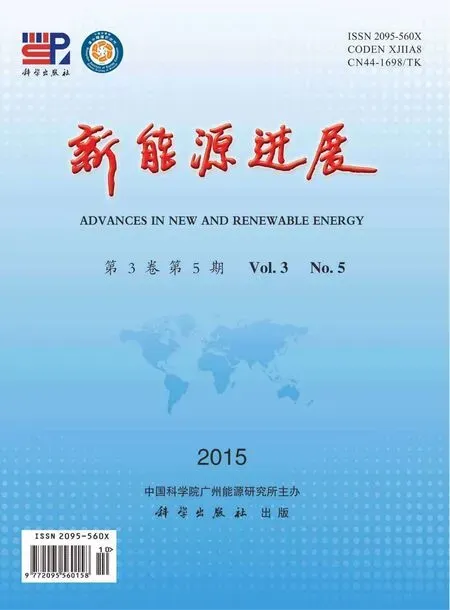二硫化钼纳米材料在化学电源中的研究进展*
黄 飞,赵 辉,冯 昊,廖振华,冉 濛,李学军,齐 敏,闫爱华1,
(1. 中国矿业大学低碳能源研究院,江苏 徐州 221008;2. 中国矿业大学材料科学与工程学院,江苏 徐州 221116)
二硫化钼纳米材料在化学电源中的研究进展*
黄 飞1,2†,赵 辉2,冯 昊2,廖振华2,冉 濛2,李学军2,齐 敏2,闫爱华1,2
(1. 中国矿业大学低碳能源研究院,江苏 徐州 221008;2. 中国矿业大学材料科学与工程学院,江苏 徐州 221116)
具有典型“三明治”二维层状结构的二硫化钼(MoS2),因其良好的双电层存储能力和层间载流子传输特性,使其成为一种理想的化学电源电极材料。本文简要阐述了MoS2材料的结构和性能特点,综述了近五年来其在化学电源应用中的最新研究进展,指出了其在应用中存在的问题与挑战,重点讨论了形貌与尺寸调控及多相复合等解决方法。最后,展望了MoS2纳米材料在化学电源中的发展方向和应用前景。
二硫化钼;纳米材料;化学电源;研究现状
0 引 言
随着传统能源所面临的资源短缺、品质下降和环境污染问题日益突出,开发新型可持续的绿色能源,已经成为我国能源发展战略中的重要组成部分。化学电源是新能源产业革命的核心,有效地解决了新能源的随机性和波动性问题,预计到2020年,国内相关产业的市场规模可达6 000亿元。
MoS2因其特殊的层状结构,具有可变的原子配位和电子结构,电子和晶格振动的简正量子(声子)之间具有很强的相互作用,层间较弱的范德华力有利于轻金属离子(如Li+、Na+、Mg2+等)的嵌入和脱嵌,同时MoS2还具有良好的双电层电荷存储能力,且Mo原子具有从+2价到+6价的氧化态,这些特性决定了其具有较高的理论储锂容量,是一种性能极好的化学电源电极材料,从而被广泛研究[1-5]。
相对于体材料,MoS2纳米材料因具有更大比表面积、更强吸附能力、更高反应活性、特殊量子效应等优异性能使其应用潜力更大,最近各种MoS2纳米电极材料被相继合成[6-7]。本文简单介绍了MoS2材料结构和性能特点,综述了近五年MoS2纳米材料在化学电源上应用的最新研究进展,指出了目前存在的问题,重点讨论了改善的方法,并展望了MoS2电极材料的发展方向和应用前景。
1 MoS2结构与性能特点
稳定的MoS2晶体呈六方密堆积,具有类石墨烯层状结构,属六方晶系,其基本结构单元是由八面体配位的Mo原子和三棱柱配位的S原子共同构成,Mo原子处于三棱柱的中心,即每个S原子与三个Mo原子相连,每个Mo原子与六个S原子相连,交替形成类似“三明治”夹层结构,也就是两个平行于(001)面的S层之间夹着一层金属Mo层,层与层(S−Mo−S)之间通过弱的范德华力相连,单层厚度仅为0.65 nm,层内(Mo−S层和Mo−Mo层)通过强的共价键和金属键连接(见图1)[8-11]。
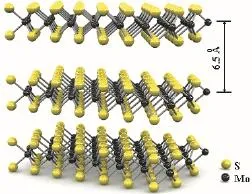
图1 MoS2结构单元示意图[11]Fig. 1 Schematic representation of MoS2unit cell[11]
正是基于这种特殊的层状结构及层间弱的范德华力,MoS2具有良好的双电层电荷存储能力及层间载流子传输特性,使得其被广泛应用于化学电源的电极材料和二极管等电子器件;同时,MoS2也是一种典型的间隙半导体,体结构材料带隙约1.9 eV,且带隙随着层厚变化在一定区间内变化(1.2 eV~1.9 eV),这种能带结构在光子激发下有利于载流子通过带隙跃迁或发射光子,使得其具有良好的光学、光电、光催化等性能,在新能源材料上具有较大的应用潜力;另外,MoS2的层状结构、弱的范德华力及六方密堆结构使得其润滑性、化学和热学稳定性极好,在固体润滑剂行业被广泛应用。
2 MoS2纳米材料在锂离子电池中的应用研究
传统锂离子电池正极材料为LiCoO2,负极材料为石墨,由于正极材料的理论储锂容量比负极材料小得多,严重制约了化学电源的进一步发展。而MoS2因其特殊的电化学特性、较好的储锂性能和高的理论比容量,可有效改善正极与负极的储锂容量差,有望解决传统锂离子电池的关键问题,其缺点是循环稳定性、可逆电容量和高倍率性能有待进一步改善。近五年来国内外研究者主要围绕形貌结构与尺寸调控,以及多相复合两个方面开展研究工作,以提升MoS2电化学性能,下面将逐一进行阐述。
2.1 形貌结构与尺寸调控
一方面,形貌结构的改变对比表面积及吸附性能有较大影响,从而影响到MoS2的储锂性能及循环稳定性;另一方面,由于MoS2为层状结构,层间距的大小直接决定了锂离子的嵌入能力,而形貌结构的改变对锂离子的嵌入与脱嵌通道以及层间距产生一定影响,从而影响锂离子电池的循环稳定性;另外,形貌结构的改变,对载流子的输运通道有一定的影响,这将显著影响锂离子电池的倍率性能[12-13]。近几年,不少学者发现优化MoS2纳米材料的形貌与结构可有效提升其电化学性能,即通过对MoS2纳米材料进行有效剪裁,制备纳米粒子[4]、纳米片[5,14]、纳米盘[15]、纳米墙[16]、纳米花[17]等具有特殊纳米结构MoS2锂离子负极材料,改善锂离子的吸附能力、嵌入通道及载流子在MoS2中的迁移速率,从而有效提升MoS2锂离子电池的电化学性能。
HWANG等[15]将Mo(CO)6前驱体和非晶单质S直接置于反应釜中,一步合成具有纳米盘结构的MoS2材料,结果显示这种纳米材料的层间距为 0.69 nm,远大于体材料,电化学结果显示该材料在50 C倍率下仍具有700 (mA·h)/g的可逆容量。SEN等[16]采用两步法成功制备具有纳米墙结构的MoS2材料,发现这种负极材料在100 mA/g倍率下循环 50次后,充放电时比容量几乎没有恶化,仍达到 880 (mA·h)/g,分析认为这种良好的性能来源于具有特殊形貌的MoS2活性成分以及纤维素粘结剂,即MoS2纳米墙的介孔特性提供了较好的初始容量,而纤维素粘结剂三维网络结构提供了更好的载流子输运通道(见图2)。
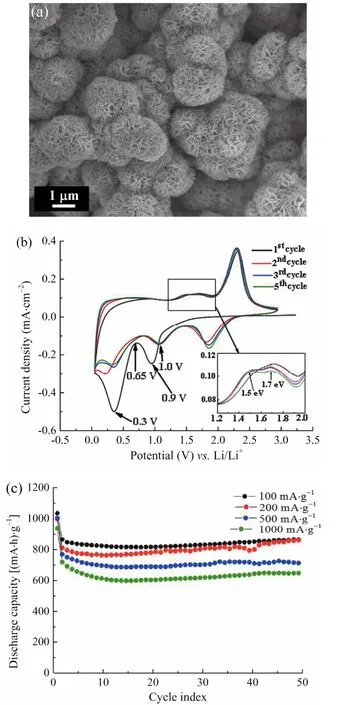
图2 MoS2纳米墙的FESEM图与电化学性能:(a)FESEM图,(b)在0.2 mV/s扫描速率下的循环伏安曲线,(c)不同倍率下循环曲线[16]Fig. 2 FESEM image and electrochemical performance of MoS2nanowall: (a) FESEM image; (b) CV curves at a scan rate of 0.2 mV/s; (c) cyclic performance at different rates[16]
另外,纳米尺寸也是改善MoS2储锂性能的重要方法,由于纳米MoS2具有更大的比表面积、更强的吸附能力及更大的层间距,使MoS2对Li+的吸附能力更强,嵌入的阻力和嵌入后造成的张应力显著降低;且纳米结构具有更强的表面活性,有利于Li+的合金化,从而使储锂性能获得显著提升[18-19]。LI等[18]采用DFT计算锂离子在体材料、MoS2纳米片和之字形MoS2纳米带中的吸附与扩散性能,结果发现:相对于MoS2体材料,MoS2纳米片和MoS2纳米带更利于锂离子的吸附与扩散,而且MoS2纳米带在提升锂离子吸附能力的同时,还可显著降低其与 锂离子的结合能,有助于锂离子的合金化。
2.2 多相复合
多相复合是改善MoS2循环性能、可逆容量和高倍率性能的另一种常用方法,即利用二元及多元成分的协同效应,以提升MoS2的电化学性能。其中,二元复合是最常见的研究方法,二元体系中又以碳材料应用最为广泛,主要是利用碳材料良好的导电性,以提高电极材料中的载流子传输速率,达到改善电化学性能的目的,同时利用碳材料膨胀系数小来抑制活性电极材料的体积效应,如MoS2/无定型碳复合材料[20-23]、MoS2/介孔碳复合材料[24-25]、MoS2/石墨烯复合材料[26-32]、MoS2/MWCNT复合材料[33-35]、MoS2/碳纤维复合材料[36]等。
ZHANG等[17]采用三步法制备MoS2/无定型碳复合材料,即在MoS2表面镀上一层无定型碳,获得碳包覆的MoS2纳米棒,发现该复合材料在200 mA/g电流密度下循环80圈后,容量仍为621 (mA·h)/g。JIANG等[25]采用模板法制备了MoS2和介孔碳层层互搭的新型纳米超晶格,发现这种材料具有良好的原子层界面接触和极高的协同效应,电化学性能表明这种负极材料的能量密度极高,且循环稳定性和高倍率性能好,在400 mA/g电流密度条件下容量达到了1 113 (mA·h)/g,且500个循环后依旧保持在1 023 (mA·h)/g(见图3)。CHANG等[26]采用L-半胱氨酸模板助剂合成了三维结构MoS2/石墨烯负极材料,当Mo∶C摩尔比为1∶2时,100 mA/g电流密度下,其容量约为1 100 (mA·h)/g。SHI等[33]采用溶剂热法制备MoS2/MWCNT二元纳米复合材料,发现MWCNT提供了极好的载流子通道,确保MoS2材料在充放电过程中高的电子导通,使得Li+很好地嵌入到S层中,在50 mA/g电流密度下,循环10圈后容量达到了1 098 (mA·h)/g,远远高于纯MWCNTs和纯MoS2的理论比容量(见图4)。
二元体系中,具有良好导电性的聚苯胺是另一种常用的材料,通过聚苯胺的加入形成MoS2/聚苯胺复合材料,有效改善了体系的电子传输能力,从而有助于锂离子电池倍率性能的提升[37-39]。YANG等制备了MoS2/聚苯胺(PANI)纳米线,当MoS2含量为66.7%时、PANI为33.1%时,复合体系容量可达1 063.9 (mA·h)/g,且100 mA/g电流密度下循环50圈后容量保持为90.2%[37]。二元体系还包括其他导电高分子[40]、硫化物[41]、氧化物[42]等,但都处于初步研究阶段。

图3 MoS2/介孔碳超晶格的FESEM图与电化学性能:(a)FESEM图,(b)孔尺寸分布曲线,(c)在0.2 mV/s扫描速率下的循环伏安曲线,(d)MoS2/介孔碳超晶格及不同MoS2/碳材料化合物在200~6 400 mA/g电流密度下的容量曲线[25]Fig. 3 FESEM image and electrochemical performance of MoS2/mesoporous carbon superstructure: (a) FESEM image; (b) pore-size distribution curve; (c) CV curves at a scan rate of 0.2 mV/s; (d) the capacities retention of MoS2/mesoporous carbon superstructure and different MoS2/carbon composites at current densities from 200 to 6 400 mA/g[25]
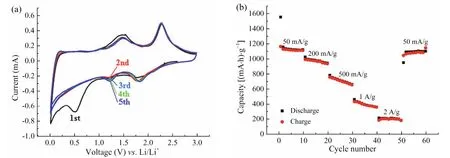
图4 MoS2/MWCNTs复合材料的电化学性能:(a) 在0.5 mV/s扫描速率下的循环伏安曲线,(b)不同倍率下的容量曲线[33]Fig. 4 Electrochemical performance of MoS2/MWCNTs composites: (a) CV curves at a scan rate of 0.5 mV/s; (b) the capacities retention at different densities[33]
另外,三元及多元也是常采用的方法,其基本原理同二元体系相似[43-45]。LINGAPPAN等[44]采用水热法合成MoS2/RGO/MWCNTs三元体系,发现在100 mA/g电流密度下容量可达到1 275 (mA·h)/g,且循环100次仍能保留93%,分析认为这种极好的电化学性能来源于体系大的比表面积、短的扩散长度和良好的载流子传输通道(见图5)。
可见,MoS2材料具有较高的理论储锂容量,目前其循环性能、可逆容量和高倍率性能可通过形貌结构调控、纳米化以及多相复合等途径得到较大改善。但对其储锂机制仍有待进一步深入研究。目前普遍认为锂离子嵌入MoS2中的过程是一种离子−电子转移的拓扑反应,即锂离子被层间弱的范德华力吸附,并将MoS2还原为Li2S和金属Mo,由于金属Mo的氧化电位较高,不易被氧化,这种导电性好的金属Mo有利于还原反应中电子的传输,从而有助于锂离子进一步吸附[46-48]。然而,实际上锂离子嵌入反应同样会导致MoS2发生重要的结构和相转变,且层间耦合、量子局域效应和对称性的改变等会使得锂离子嵌入前后结构性质发生本质的变化[49-50]。尽管这些现象已引起行业人士的重视,但现有的研究主要集中在单层MoS2以及机械剥离制备的MoS2纳米片上,对其他MoS2纳米材料的锂化过程缺少详细的理论研究,同时锂离子嵌入在相变过程中的位置迁徙及锂化过程中的理论分析同制备工艺之间的构建关系也需要进一步厘清[51-52]。
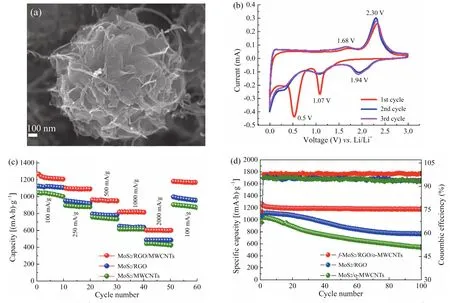
图5 MoS2/RGO/MWCNTs化合物的FESEM图与电化学性能:(a)FESEM图,(b)在0.1 mV/s扫描速率下的循环伏安曲线,(c)不同倍率下的比容量曲线,(d)100 mA/g倍率下的循环性能[44]Fig. 5 FESEM image and electrochemical performance of MoS2/RGO/MWCNTs composites: (a) FESEM image; (b) CV curves at a scan rate of 0.1 mV/s; (c) the capacities retention at different rates; (d) cyclic properties at the rate of 100 mA/g[44]
3 MoS2纳米材料在超级电容器中的应用研究
由于超级电容器主要是利用电极与电解液界面的双电层能量,因此获得较大比表面积电极材料对超级电容器非常有利。传统的碳材料尽管比表面积大,容量也大,但实际使用率较低,功率密度有待改善,且碳表面官能团对电容量存在一定负面效果;另外,高比表面积碳材料的成本较高,极大地限制了其广泛应用[53]。另一种广泛研究的材料是导电高分子,如聚吡咯、聚苯胺、聚噻吩等,因存在电压过大、循环寿命低、毒性大、环境污染严重等问题,在实际应用中需要对这些问题进行解决[54]。
因此,开发一些新型的电极材料显得非常迫切,如金属氧化物、二维层状材料等,其中类石墨烯结构MoS2材料因其特殊的结构、快速的离子电导、高的比电容,且“三明治”结构中的Mo层之间的电子关联有助于载流子的传输,是一种极好的超级电容器的电极材料,受到了人们的广泛关注[55]。目前,MoS2电极材料在超级电容器中的研究方向和研究思路主要利用MoS2高的理论比容量来提高超级电容器的能量密度和功率密度。
具体而言,MoS2电极材料的研究主要集中在MoS2形貌及结构控制、MoS2/碳材料及MoS2/导电高分子复合材料制备与性能研究这几个方面[56-60]。ILANCHEZHIYAN等[56]采用水热法制备了纳米球结构MoS2,电化学测试结果显示其比容量、能量密度和功率密度分别为122 F/g、17 (W·h)/kg和204 W/kg,表明这是一种极好的超级电容器电极材料(见图6)。HUANG等以钼酸钠为原材料,采用水热法成功制备MoS2/MWCNTs复合材料,发现其比容量达到了452.7 F/g,且循环1 000次后,仍能保持412.2 F/g,分析认为这主要源自于复合电极良好的电荷传输能力、电解液扩散能力以及低的体积膨胀系数[59]。尽管MoS2电极材料在超级电容器上取得了一定的研究进展,但在电极制备工艺方面,尤其是电极接触,以及长期运行的稳定性,如物相结构、电子结构及嵌入/脱嵌的稳定性,还有待进一步改善。
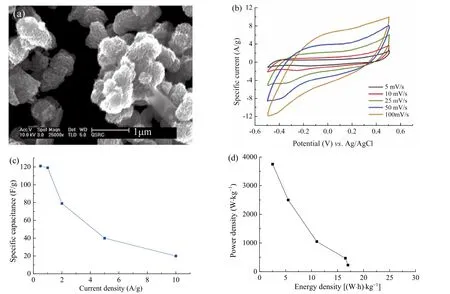
图6 MoS2纳米墙的FESEM图与电化学性能:(a)FESEM图,(b)不同扫描速率下的循环伏安曲线,(c)不同电流密度下的比容量曲线,(d)Ragone曲线[56]Fig. 6 FESEM image and electrochemical performance of MoS2nanowall: (a) FESEM image; (b) CV curves at different current densities; (c) speci fi c capacitance at different scan rates; (d) Ragone plot[56]
4 MoS2纳米材料在钠离子电池中的应用研究
钠离子电池因其资源丰富、价格低廉、半电池电位高、安全性好,成为近几年研究的热点。然而,钠离子的原子质量与离子直径大,导致钠离子电池存在电化学反应过程中动力学较慢、电容量偏低,以及离子在电极材料中嵌入/脱嵌困难,大电流充放电性能不理想,不可逆容量损失较大等缺点[61]。作为一种典型的二维层状结构材料,MoS2电极材料因其结构稳定,且层间距可调,能够有效改善传统负极材料电池容量低及硬碳材料嵌入/脱嵌难等问题,引起了人们的重视[62-68]。
目前MoS2电极材料在钠离子电池中的应用研究主要集中在负极材料上,包括多相复合和纳米结构设计。XIE等采用两步法制备了MoS2/石墨烯复合材料,发现这种复合材料界面的协同效应可有效改善电极的电导、钠离子嵌入能力以及钠离子扩散迁移能力,在540 mA/g电流密度下可逆容量达到352 (mA·h)/g[66]。HU等采用水热法,成功合成MoS2纳米花,发现其充放电容量和循环性能显著改善,在0.05 A/g电流密度下可逆容量达到350 (mA·h)/g,且充放电300次基本没有变化(见图7)[68]。
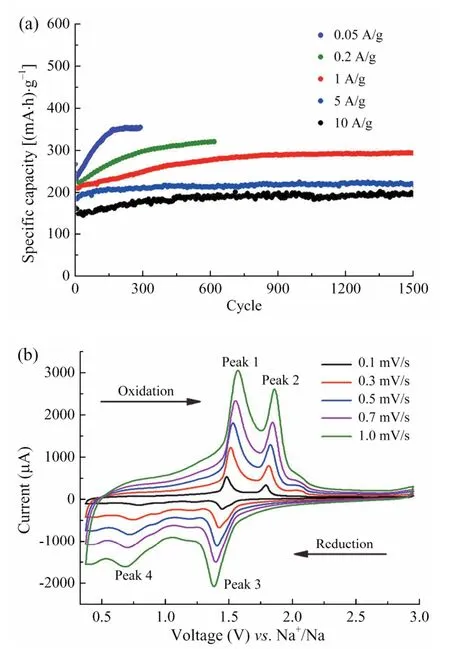
图7 MoS2纳米花的电化学性能:(a)不同倍率下循环性能,(b)不同扫描速率下的CV曲线[68]Fig. 7 Electrochemical performance of MoS2nanoflowers: (a) cyclic properties at different rates; (b) CV curves at different scan rates[68]
由于钠离子电池属于新型化学电源,相关研究起步晚,未来MoS2电极材料在钠离子电池中的应用还需要解决一些问题:包括电化学过程中的MoS2纳米材料的结构重堆现象、偏弱的循环性能、脱嵌机理,以及比容量改善等。
5 MoS2纳米材料在其他化学电源中的应用研究
除了在锂离子电池、超级电容器和钠离子电池上应用外,MoS2还在锂硫电池[69-70]、镁离子电池[71]、锂空电池[72]等化学电源中获得广泛应用。MoS2在锂硫电池上的应用研究主要集中在锂硫电池的正极材料,即利用MoS2来改善正极导电性和穿梭效应等问题;镁离子电池主要是利用MoS2良好的结构与化学稳定性,来改善镁离子电池的化学动力学的稳定性,同时降低镁离子电池的电极材料在电解液中的极化率,并提升循环性能;锂空电池主要是利用MoS2良好的双电层电荷效应来改善循环性能。
ZHANG等[69]采用两步水热法,成功合成MoS2/SnO2分等级纳米结构,在80次循环及0.2 C倍率条件下可逆容量达到905.8 (mA·h)/g,分析认为其优良的电化学性能主要来源于Li2O中间产物,从而阻止了Li2S的扩散,且这种分等级纳米结构有利于Li离子的嵌入,是一种较好的锂硫电池正极材料。目前,MoS2纳米材料在镁离子电池和锂空电池中的研究较少,相关工作还有待进一步开展和深入。
6 结论与展望
MoS2纳米材料由于其特殊的结构特性,表现出优异的电化学性能,因而在锂离子电池、超级电容器、钠离子电池、锂硫电池、镁离子电池等化学电源领域具有较大的应用前景。然而,MoS2在化学电源领域的研究还处于起步阶段,其循环稳定性、可逆电容量和高倍率性能有待进一步改善。目前大部分工作都围绕MoS2纳米材料的制备与性能表征,形貌结构的调控对电化学性能的影响,纳米化对电化学性能的改善,及MoS2复合体系协同效应对电化学性能的优化这几个方面开展。未来MoS2化学电源的研究既要关注其本身优势,也要把握其应用中存在的问题,重点解决电化学运行机理、优化电极制备工艺、改善MoS2电极材料的物相与结构稳定性、电化学循环稳定性等问题。
[1] HAN S W, KWON H, KIM S K, et al. Band-gap transition induced by interlayer van der Waals interaction in MoS2[J]. Phys. Rev. B, 2011, 84(4): 045409.
[2] DAVID L, BHANDAVAT R, BARRERA U, et al. Polymer-derived ceramic functionalized MoS2composite paper as a stable lithium-ion battery electrode[J]. Sci. Rep., 2015, 5: 9792.
[3] PARK S K, YU S H, WOO S, et al. A simple L-cysteine assisted method for the growth of MoS2nanosheets on carbon nanotubes for high-performance lithium ion batteries[J]. Dalton T., 2013, 42(7): 2399-2405.
[4] WANG M, LI G, XU H, et al. Enhanced lithium storage performances of hierarchical hollow MoS2nanoparticles assembled from nanosheets[J]. ACS Appl. Mater. Inter., 2013, 5(3): 1003-1008.
[5] XU B, WANG L, CHEN H J, et al. Adsorption and diffusion of lithium on 1T-MoS2monolayer[J]. Comp. Mater. Sci., 2014, 93: 86-90.
[6] PARK S K, YU S H, WOO S, et al. A facile and green strategy for the synthesis of MoS2nanospheres with excellent Li-ion storage properties[J]. CrystEngComm, 2012, 14(24): 8323-8325.
[7] STEPHENSON T, LI Z, OLSEN B, et al. Lithium ion battery applications of molybdenum disulfide (MoS2) nanocomposites[J]. Energ. Environ. Sci., 2013, 7(1): 209-231.
[8] BALENDHRAN S, OU J Z, BHASKARAN M, et al. Atomically thin layers of MoS2via a two step thermal evaporation- exfoliation method[J]. Nanoscale, 2012, 4(2): 461-466.
[9] LUQUE A, MARTÍ A, STANLEY C. Understanding intermediate-band solar cells[J]. Nat. Photonics, 2012, 6: 146-152.
[10] CHEIWCHANCHAMNANGIJ T, LAMBRECHT W R L. Quasiparticle band structure calculation of monolayer, bilayer, and bulk MoS2[J]. Phys. Rev. B, 2012, 85: 205302.
[11] RADISAVLJEVIC B, RADENOVIC A, BRIVIO J, et al. Single-layer MoS2transistors[J]. Nat. Nanotechnol., 2011, 6(3): 147-150.
[12] WANG X, ZHANG Z, CHEN Y, et al. Morphology- controlled synthesis of MoS2nanostructures with different lithium storage properties[J]. J. Alloys Compd., 2014, 600: 84-90.
[13] XU X, LIU W, KIM Y, et al. Nanostructured transition metal sul fi des for lithium ion batteries: Progress and challenges[J]. Nano Today, 2014, 9: 604-630.
[14] LIU Y, REN L, QI X, et al. Hydrothermal exfoliated molybdenum disulfide nanosheets as anode material for lithium ion batteries[J]. J. Energ. Chem., 2014, 23: 207-212.
[15] HWANG H, KIM H, CHO J. MoS2nanoplates consisting of disordered graphene-like layers for high rate lithium battery anode materials[J]. Nano Lett., 2011, 11(11): 4826-4830.
[16] SEN U K, MITRA S. High-rate and high-energy-density lithium-ion battery anode containing 2D MoS2nanowall and cellulose binder[J]. ACS Appl. Mater. Inter., 2013, 5(4): 1240-1247.
[17] YANG T, CHEN Y, QU B, et al. Construction of 3D flower-like MoS2spheres with nanosheets as anode materials for high-performance lithium ion batteries[J]. Electrochim. Acta, 2014, 115: 165-169.
[18] LI Y, WU D, ZHOU Z, et al. Enhanced Li adsorption and diffusion on MoS2zigzag nanoribbons by edge effects: A computational study[J]. J. Phys. Chem. Lett., 2012, 3: 2221-2227.
[19] SUN P L, ZHANG W X, HU X L, et al. Synthesis of hierarchical MoS2and its electrochemical performance as anode material for lithium-ion batteries[J]. J. Mater. Chem. A, 2014, 2: 3498-3504.
[20] ZHANG C, WU H B, GUO Z, et al. Facile synthesis of carbon-coated MoS2nanorods with enhanced lithium storage properties[J]. Electrochem. Commun., 2012, 20: 7-10.
[21] DAS S K, MALLAVAJULA R, JAYAPRAKASH N, et al. Self-assembled MoS2-carbon nanostructures: Influence of nanostructuring and carbon on lithium battery performance[J]. J. Mater. Chem., 2012, 22(26): 12988-12992.
[22] ZHANG C, WANG Z, GUO Z, et al. Synthesis of MoS2-C one dimensional nanostructures with improved lithium storage properties[J]. ACS Appl. Mater. Inter., 2012, 4(7): 3765-3768.
[23] QIU W, XIA J, HE S, et al. Facile synthesis of hollow MoS2microspheres/amorphous carbon composites and their lithium storage properties[J]. Electrochim. Acta, 2014, 117: 145-152.
[24] ZHOU X, WAN L J, GUO Y G. Facile synthesis of MoS2@CMK-3 nanocomposite as an improved anode material for lithium-ion batteries[J]. Nanoscale, 2012, 4(19): 5868-5871.
[25] JIANG H, REN D, WANG H, et al. 2D monolayer MoS2–carbon interoverlapped superstructure: Engineering ideal atomic interface for lithium ion storage[J]. Adv. Mater., 2015, 27: 3687-3695.
[26] CHANG K, CHEN W. L-cysteine-assisted synthesis of layered MoS2/graphene composites with excellent electrochemical performances for lithium ion batteries[J]. ACS Nano, 2011, 5(6): 4720-4728.
[27] GUO J, CHEN X, JIN S, et al. Synthesis of graphene-like MoS2nanowall/graphene nanosheet hybrid materials with high lithium storage performance[J]. Catal. Today, 2015, 246: 165-171.
[28] YANG M H, KO S, IM J S, et al. Free-standing molybdenum disulfide/graphene composite paper as a binder- and carbon-free anode for lithium-ion batteries[J]. J. Power Sources, 2015, 288: 76-81.
[29] ZHAO Y, KUAI L, LIU Y, et al. Well-constructed single-layer molybdenum disulfide nanorose cross-linked by three dimensional-reduced graphene oxide network for superior water splitting and lithium storage property[J]. Sci. Rep., 2014, 5: 8722.
[30] MA L, HUANG G, CHEN W, et al. Cationic surfactant-assisted hydrothermal synthesis of few-layer molybdenum disulfide/graphene composites: Micro- structure and electrochemical lithium storage[J]. J. Power Sources, 2014, 264: 262-271.
[31] MA L, YE J, CHEN W, et al. Gemini surfactant assisted hydrothermal synthesis of nanotile-like MoS2/graphene hybrid with enhanced lithium storage performance[J]. Nano Energy, 2014, 10: 144-152.
[32] JING Y, ORTIZ-QUILES E O, CABRERA C R, et al. Layer-by-layer hybrids of MoS2and reduced graphene oxide for lithium ion batteries[J]. Electrochim. Acta, 2014, 147: 392-400.
[33] SHI Y, WANG Y, WONG J I, et al. Self-assembly of hierarchical MoSx/CNT nanocomposites (2<x<3): Towards high performance anode materials for lithium ion batteries[J]. Sci. Rep., 2013, 3: 2169.
[34] BINDUMADHAVAN K, SRIVASTAVA S K, MAHANTY S. MoS2-MWCNT hybrids as a superior anode in lithium-ion batteries[J]. Chem. Commun., 2013, 49(18): 1823-1825.
[35] DAS S K. Coaxial growth of carbon coated MoS2nanoparticles on carbon nanotube and their electrochemical evaluation[J]. Mater. Lett., 2014, 130: 240-244.
[36] ZHOU F, XIN S, LIANG H W, et al. Carbon nanofibers decorated with molybdenum disulfide nanosheets: Synergistic lithium storage and enhanced electrochemical performance[J]. Angew. Chem., 2014, 126: 11736-11740.
[37] YANG L, WANG S, MAO J, et al. Hierarchical MoS2/polyaniline nanowires with excellent electrochemical performance for lithium-ion batteries[J]. Adv. Mater., 2013, 25(8): 1180-1184.
[38] LIU H, ZHANG F, LI W, et al. Porous tremella-like MoS2/polyaniline hybrid composite with enhanced performance for lithium-ion battery anodes[J]. Electrochim. Acta, 2015, 167: 132-138.
[39] WANG J, WU Z, HU K, et al. High conductivity graphene-like MoS2/polyaniline nanocomposites and its application in supercapacitor[J]. J. Alloys Compd., 2015, 619: 38-43.
[40] ZHAO X, MAI Y, LUO H, et al. Nano-MoS2/poly (3,4-ethylenedioxythiophene): Poly(styrenesulfonate) composite prepared by a facial dip-coating process for Li-ion battery anode[J]. Appl. Surf. Sci., 2014, 288: 736-741.
[41] WANG J, CHAO D, LIU J, et al. Ni3S2@MoS2core/shell nanorod arrays on Ni foam for high-performance electrochemical energy storage[J]. Nano Energy, 2014, 7: 151-160.
[42] ZHUANG W, LI L, ZHU J, et al. Facile synthesis of mesoporous MoS2-TiO2nanofibers for ultrastable lithium ion battery anodes[J]. ChemElectroChem, 2015, 2: 374-381.
[43] HAN S, ZHAO Y, TANG Y, et al. Ternary MoS2/SiO2/ graphene hybrids for high-performance lithium storage[J]. Carbon, 2015, 81: 203-209.
[44] LINGAPPAN N, VAN N H, LEE S, et al. Growth of three dimensional flower-like molybdenum disulfide hierarchical structures on graphene/carbon nanotube network: An advanced heterostructure for energy storage devices[J]. J. Power Sources, 2015, 280: 39-46.
[45] HOU Y, LI J, WEN Z, et al. N-doped graphene/porous g-C3N4nanosheets supported layered-MoS2hybrid as robust anode materials for lithium-ion batteries[J]. Nano Energy, 2014, 8: 157-164.
[46] WANG L, XU Z, WANG W, et al. Atomic mechanism of dynamic electrochemical lithiation processes of MoS2nanosheets[J]. J. Am. Chem. Soc., 2014, 136(18): 6693-6697.
[47] FANG X, HUA C, GUO X, et al. Lithium storage in commercial MoS2in different potential ranges[J]. Electrochim. Acta, 2012, 81: 155-160.
[48] ENYASHIN A N, SEIFERT G. Density-functional study of LixMoS2intercalatesComput. Theor. Chem., 2012, 999: 13-20.
[49] ENYASHIN A N, YADGAROV L, HOUBEN L, et al. New route for stabilization of 1T-WS2and MoS2phases[J]. J. Phys. Chem. C, 2011, 115: 24586-24591.
[50] LIN F, NORDLUND D, WENG T C, et al. Phase evolution for conversion reaction electrodes in lithium- ion batteries[J]. Nat. Commun., 2014, 5: 3358-3366.
[51] WANG L, XU Z, WANG W, et al. Atomic mechanism of dynamic electrochemical lithiation processes of MoS2nanosheets[J]. J. Am. Chem. Soc., 2014, 136: 6693-6697.
[52] LIN Y C, DUMCENCO D O, HUANG Y S, et al. Atomic mechanism of the semiconducting-to-metallic phase transition in single-layered MoS2[J]. Nat. Nanotechnol., 2014, 9: 391-396.
[53] YANG Z, REN J, ZHANG Z, et al. Recent advancement of nanostructured carbon for energy applications[J]. Chem. Rev., 2015, 115(11): 5159-5223.
[54] WANG G, ZHANG L, ZHANG J. A review of electrode materials for electrochemical supercapacitors[J]. Chem. Soc. Rev., 2012, 41: 797-828.
[55] PENG X, PENG L, WU C, et al. Two dimensional nanomaterials for flexible supercapacitors[J]. Chem. Soc. Rev., 2014, 43: 3303-3323.
[56] ILANCHEZHIYAN P, KUMAR G M, KANG T W. Electrochemical studies of spherically clustered MoS2nanostructures for electrode applications[J]. J. Alloys Compd., 2015, 634: 104-108.
[57] MA L, XU L M, ZHOU X P, et al. Biopolymer-assisted hydrothermal synthesis of flower-like MoS2microspheres and their supercapacitive properties[J]. Mater. Lett., 2014, 132: 291-294.
[58] HUANG K J, ZHANG J Z, SHI G W, et al. Hydrothermal synthesis of molybdenum disulfide nanosheets as supercapacitors electrode material[J]. Electrochim. Acta, 2014, 132: 397-403.
[59] HUANG K J, WANG L, ZHANG J Z, et al. One-step preparation of layered molybdenum disul fi de/multi-walled carbon nanotube composites for enhanced performance supercapacitor[J]. Energy, 2014, 67: 234-240.
[60] FIRMIANO E G D S, RABELO A C, DALMASCHIO C J, et al. Supercapacitor electrodes obtained by directly bonding 2D MoS2on reduced graphene oxide[J]. Adv. Energ. Mater., 2014, 4: 1301380.
[61] ISLAM M S, FISHER C A J. Lithium and sodium battery cathode materials: computational insights into voltage, diffusion and nanostructural properties[J]. Chem. Soc. Rev., 2014, 43: 185-204.
[62] MORTAZAVI M, WANG C, DENG J, et al. Ab initio characterization of layered MoS2as anode for sodium-ion batteries[J]. J. Power Sources, 2014, 268: 279-286.
[63] QIN W, CHEN T, PAN L, et al. MoS2-reduced graphene oxide composites via microwave assisted synthesis for sodium ion battery anode with improved capacity and cycling performance[J]. Electrochim. Acta, 2015, 153: 55-61.
[64] WANG J, LUO C, GAO T, et al. An advanced MoS2/carbon anode for high-performance sodium-ion batteries[J]. Small, 2015, 11: 473-481.
[65] WANG X, LI Y, GUAN Z, et al. Micro-MoS2with excellent reversible sodium-ion storage[J]. Chem. Eur. J., 2015, 21: 6465-6468.
[66] XIE X, AO Z, SU D, et al. MoS2/graphene composite anodes with enhanced performance for sodium-ion batteries: The role of the two-dimensional heterointerface[J]. Adv. Funct. Mater., 2015, 25: 1393-1403.
[67] WANG Y X, CHOU S L, WEXLER D, et al. High- performance sodium-ion batteries and sodium-ion pseudocapacitors based on MoS2/graphene composites[J]. Chem. Eur. J., 2014, 20: 9607-9612.
[68] HU Z, WANG L, ZHANG K, et al. MoS2nanoflowers with expanded interlayers as high-performance anodes for sodium-ion batteries[J]. Angew. Chem., 2014, 126: 13008-13012.
[69] ZHANG D A, WANG Q, WANG Q, et al. High capacity and cyclability of hierarchical MoS2/SnO2nanocomposites as the cathode of lithium-sulfur battery[J]. Electrochim. Acta, 2015, 173: 476-482.
[70] SEH Z W, YU J H, LI W, et al. Two-dimensional layered transition metal disulphides for effective encapsulation of high-capacity lithium sulphide cathodes[J]. Nat. Commun., 2014, 5: 5017-5024.
[71] LIU Y, JIAO L, WU Q, et al. Synthesis of rGO-supported layered MoS2for high-performance rechargeable Mg batteries[J]. Nanoscale, 2013, 5: 9562-9567.
[72] ZHANG P, LU X, HUANG Y, et al. MoS2nanosheets decorated with gold nanoparticles for rechargeable Li–O2batteries[J]. J. Mater. Chem. A, 2015, 3: 14562-14566.
Research Progress of Molybdenum Disulfide Nano Materials Used for Chemical Power Source
HUANG Fei1,2, ZHAO Hui2, FENG Hao2, LIAO Zhen-hua2, RAN Meng2, LI Xue-jun2, QI Min2, YAN Ai-hua1,2
(1. Low Carbon Energy Institute, China University of Mining & Technology, Jiangsu Xuzhou 221008, China; 2. School of Materials Science and Engineering, China University of Mining & Technology, Jiangsu Xuzhou 221116, China)
Due to its good charge storage in electric double layer and rapid interlayer carrier transport, molybdenum disulfide (MoS2) with typically “sandwich-like” two-dimensional layered structure is a kind of ideal electrode materials for chemical power sources. In this paper, the structure and performance characteristics of MoS2materials were briefly introduced. Research progresses of MoS2materials used in chemical power sources were reviewed in recent five years. The main problems and challenges of MoS2nanomaterials were analyzed. The solutions were emphatically discussed, especially the modulation of morphology and size. Finally, the development direction and application prospects of MoS2nanomaterials in the future were summarized.
molybdenum disulfide; nanomaterials; chemical power source; investigation progresses
TK02;O646
A
10.3969/j.issn.2095-560X.2015.05.009
2095-560X(2015)05-0375-09
黄 飞(1978-),男,博士,副研究员,硕士生导师,主要从事微纳新能源材料与器件(化学储能及太阳能)方面的应用研究。
2015-07-03
2015-09-29
江苏省自然科学基金(20141133,20130195);中央高校基本科研业务费(2013QNA07,2015XKMS096)
† 通信作者:黄 飞,E-mail:huangfei7804@163.com
赵 辉(1991-),男,硕士研究生,主要从事新型负极材料在化学电源中的应用研究。

